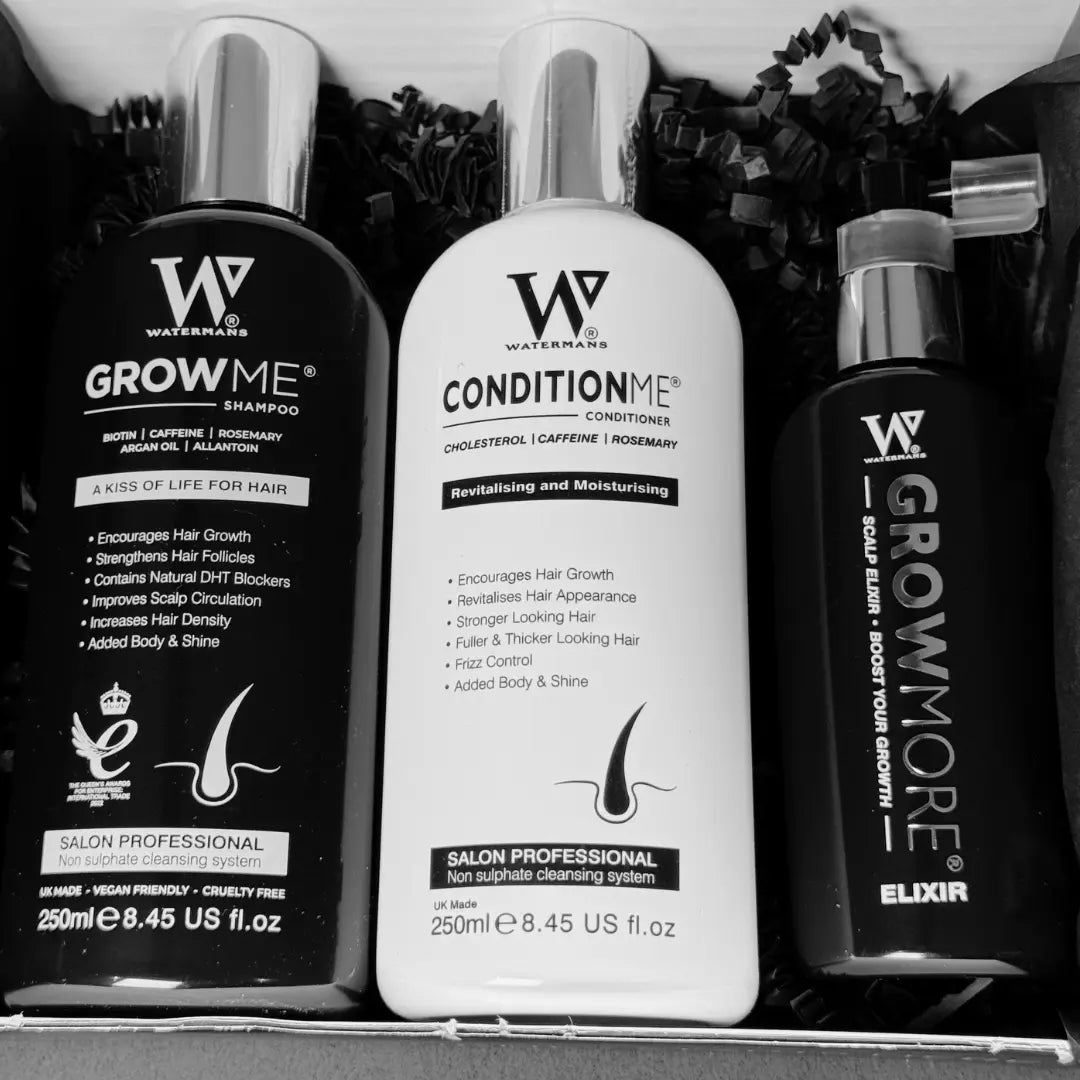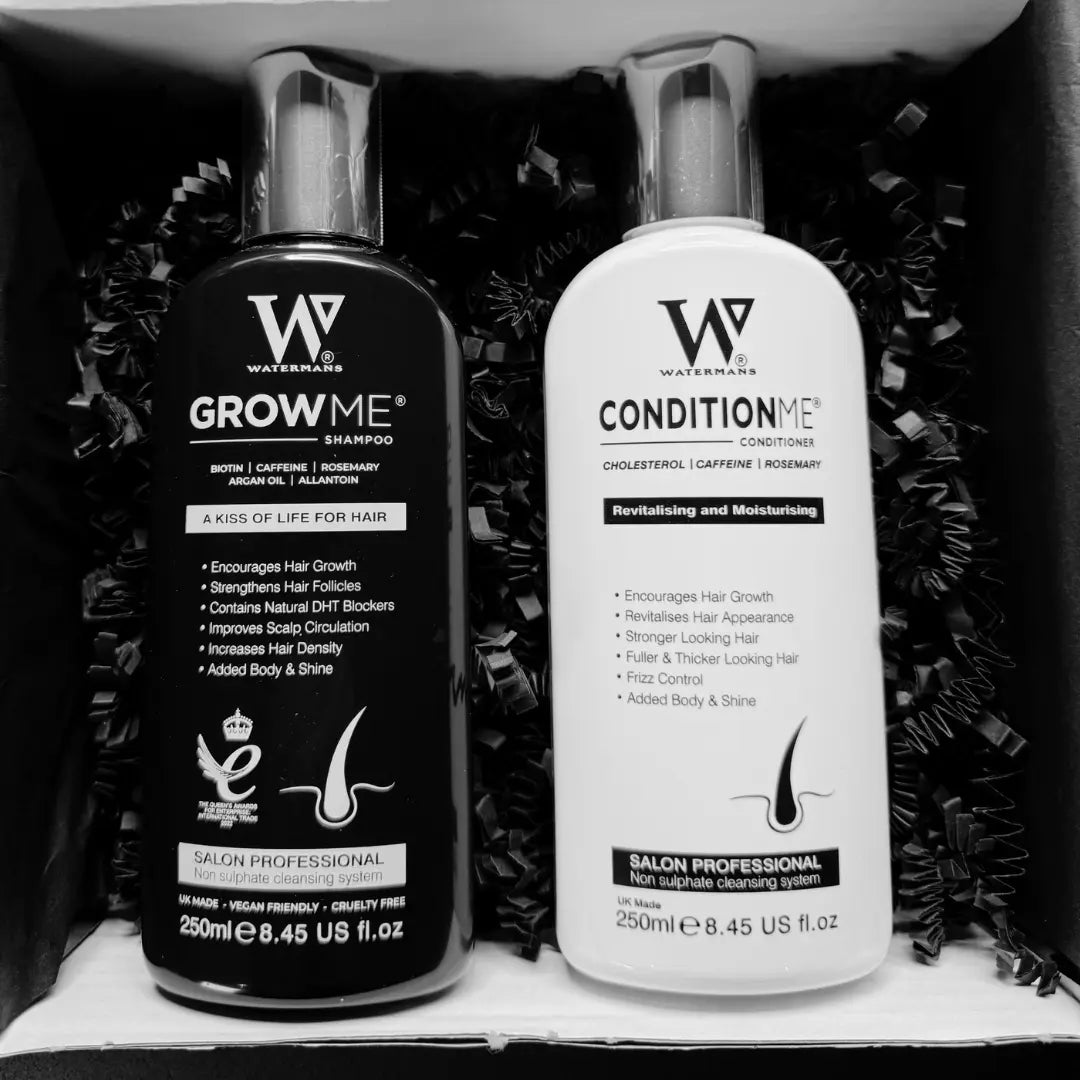
Finasteride Transgender Use: Benefits, Risks, and What to Expect
When it comes to hormone therapy and hair care, many transgender people choose drugs to fit their gender identity and keep a healthy scalp and hair. One medicine is finasteride, which helps with hair loss and hormone-related hair issues. This detailed guide explains finasteride in transgender care. It shows its benefits, risks, how it works, and what to expect.
If you seek hair growth options with your hormone treatment, try natural solutions as well. Watermans Grow Me Shampoo has biotin, rosemary, and caffeine. These ingredients help your scalp and add volume to hair. This shampoo works with other treatments and may support hair well-being.
What Is Finasteride and How Does It Work in Transgender Care?
Finasteride is a drug made to treat male baldness and prostate enlargement. It stops an enzyme called 5-alpha-reductase. This enzyme changes testosterone into dihydrotestosterone (DHT). DHT causes hair loss in many men.
Transgender people, mainly transgender women, may use finasteride to lower DHT. It slows or stops hair loss from androgens. In hormone replacement therapy, transgender women lower testosterone and raise estrogen. Finasteride works with this plan by cutting the androgens that shrink hair follicles.
Finasteride and Transgender Men
Transgender men usually do not use finasteride because their therapy raises testosterone. Still, some transgender men with hair loss that is not linked to androgens may try the drug. They should talk with their doctor for advice.
Benefits of Using Finasteride for Transgender People
1. Slowing Hair Loss
Transgender women may use finasteride to slow hair loss. The drug lowers DHT. With less DHT, hair follicles shrink less, which slows thinning over time.
2. Potential Hair Regrowth
Finasteride mainly stops hair loss. Some people see a bit of hair grow back. This change comes after several months of regular use. Results differ from one person to another.
3. Better Scalp Health
By cutting the effect of androgens, finasteride makes life easier for hair follicles. It lowers inflammation and sensitivity, which may help keep your scalp and hair in good shape.

4. Working with Hormone Therapy
Transgender women on hormone therapy can use finasteride too. Hormone treatment adjusts overall hormone levels. Finasteride lowers DHT. They work together to help protect your hair.
Risks and Side Effects of Finasteride for Transgender Use
1. Sexual Dysfunction
Some people see a drop in libido, trouble with erections, or changes in orgasm with finasteride. These effects might fade if you stop the drug. In some cases, they can last.
2. Changes in Mood and Mental Health
Some report anxiety, depression, or mood swings when using finasteride. It helps to watch your feelings and talk with your doctor if problems occur.
3. Impact on Hormone Levels
Finasteride lowers DHT but does not change testosterone directly. This change might misalign hormone levels. For transgender women on therapy, doctors should keep a close watch.
4. Pregnancy Risk for Transgender Men Partners
Finasteride can harm a fetus. This risk matters if your partner might get pregnant. Take care if you share finasteride in a home where pregnancy is possible.
5. Other Less Common Side Effects
- Breast tenderness or enlargement
- Allergic skin reactions
- Dizziness or headache
What to Expect When Using Finasteride as a Transgender Person
Timeline for Results
- 2-4 Months: No big change. Hair might fall out more at first. This is a normal phase.
- 4-6 Months: Some new hair may appear. The change is slight.
- 6-12 Months: Many see thicker hair and less loss.
- After 12 Months: Keep using finasteride to hold your gains.
Dosage and Administration
For hair loss, the usual dose is 1 mg per day. Talk with your doctor to adjust the dose along with your hormone plan.
Regular Monitoring
Finasteride affects hormones. It is wise to have blood tests and check-ups to track hormone levels and spot side effects.
Alternative Hair Loss Treatments for Transgender People
Finasteride can work well, but it is not the only option. Other methods depend on how much hair you lose, your hormone levels, and what you prefer:
- Minoxidil topical solution: A common treatment that helps hair grow without affecting your whole body.
- Hair transplant surgery: A long-term choice that needs careful thought.
- Spironolactone: An anti-androgen used by some transgender women to lower testosterone effects.
- Natural products and shampoos: Watermans Grow Me Shampoo has biotin, caffeine, and argan oil. It may support hair as you use other treatments.
Benefits of Watermans Grow Me Shampoo
- It has niacinamide, caffeine, and lupin protein that wake up the scalp.
- It uses allantoin and argan oil to feed hair follicles and add volume.
- It avoids strong chemicals found in some other treatments.
You can use Watermans shampoo along with finasteride to help keep your scalp and hair healthy.
Practical Tips for Transgender People Using Finasteride
- Consult Your Healthcare Provider: Talk with your doctor and share your hormone plan and medical history.
- Start with a Low Dose: Some doctors suggest beginning with a low dose to see how you react.
- Be Patient: Hair care takes time. Do not expect fast change.
- Monitor Side Effects: Write down any changes in your mood, body, or sexual health.
- Use Natural Hair Care: A product like Watermans Grow Me Shampoo may support your scalp as you use finasteride.
- Avoid Pregnancy Exposure: Take precautions if you share your home with someone who might become pregnant.
Frequently Asked Questions (FAQs)
Q1: Is finasteride safe for transgender women?
For transgender women, finasteride is usually safe when a doctor watches its use. Still, side effects and drug interactions need to be checked.
Q2: Can transgender men use finasteride for hair loss?
Finasteride is less common for transgender men. Their therapy raises testosterone, which can lessen the drug’s effect. They might try other options with their specialist.
Q3: How long before finasteride works for hair loss in transgender users?
Some see results in 4-6 months. Full benefits may need 12 months of use. Patience and a steady routine matter.
Empower Your Hair Journey with Watermans Hair Care
Managing hormone treatment and hair care can be hard. With finasteride and natural hair care, you can care for your hair while you change your hormones. Try Watermans Grow Me Shampoo—it uses natural ingredients to wake up your scalp and add volume to your hair.
For a full solution, check out the Watermans Hair Survival Kit. This set of products helps your hair grow during hormonal changes.
By mixing safe medical treatments with natural hair care, transgender people can care for the hair they want as they adjust their hormones.
For more reading on hair loss and how finasteride works, visit the Mayo Clinic’s page on finasteride use.













